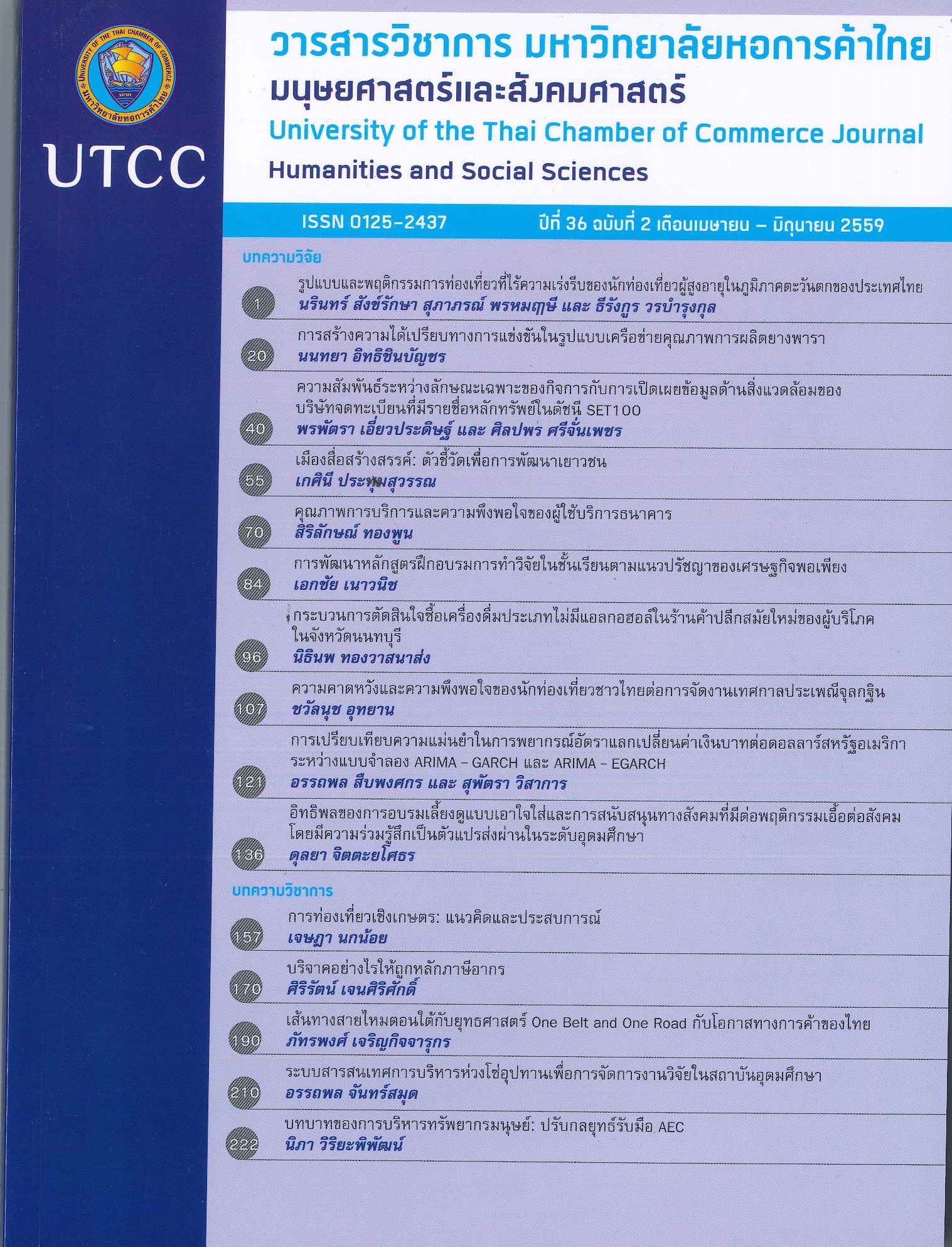The Competitive Advantage of Quality Rubber Production Network
Main Article Content
Abstract
The research aimed to study and construct a quality rubber production network model. The study employed the participatory action research (PAR) method involving focus group discussions. and using in-depth interviews and observation techniques for data collection. Data analysis and synthesis used the inductive method. The study had three phases. The first phase was desigred to investigate the state of events and rubber production in Pusing District. The second phase was intended to study the competitive advantage for a quality rubber production network. The third phases included presentation of a competitive advantage for a quality rubber products network
model. The research findings were as follows: the current stage of the rubber farmers network lacked development. collaboration and awareness: environmental aspect potential exists for constructing a competitive advantage for a quality rubber production network in the study area: and the need of finding a collaborative leader to promote regulations leading to a competitive advantage for a quality rubber production network. such as a rubber center, acting, communication, and collaboration activities. Finally, there were five mechanism aspects in management: personnel. production. marketing.financial and accounting for the continuation of the evaluation.
Article Details
ลิขสิทธิ์ของบทความ
ผลงานที่ได้รับการตีพิมพ์ถือเป็นลิขสิทธิ์ของมหาวิทยาลัยหอการค้าไทย ห้ามมิให้นำเนื้อหา ทัศนะ หรือข้อคิดเห็นใด ๆ ของผลงานไปทำซ้ำ ดัดแปลง หรือเผยแพร่ ไม่ว่าทั้งหมดหรือบางส่วนโดยไม่ได้รับอนุญาตเป็นลายลักษณ์อักษรจากมหาวิทยาลัยหอการค้าไทยก่อน
References
ประพันธ์ ช่วงภูศรี. 2550. “การพัฒนาองค์การ.” พัฒนาชุมชน 46,11: 51-52.
Crosby,Philip B. 2005. The Strategy of Situation Management: A New and Unique Approach to Managing Personal and Business Problems more Effectively.Boston, MA:Industrial Education Institute.
Evans, J. R., and Dean, J. W. 2003. Total Quality : Management, Organization and Strategy. 3rd ed. Cincinnati, OH: South-Western.
Ittichinbanchon, Nontaya. 2013. “ Value Chain Management for Increasing Value of Exports in Lower Northeastern Thailand.” University of the Thai Chamber of Commerce Journal 33,4 :1-13.(in Thai).
นนทยา อิทธิชินบัญชร. 2556. “การจัดการห่วงโซ่คุณค่ายางพาราเพื่อเพิ่มมูลค่าในการส่งออกในเขตภาคตะวันออกเฉียงเหนือตอนล่าง.” วารสารวิชาการ มหาวิทยาลัยหอการค้าไทย 33, 4 : 1-13.
Palasri, Soantaya . 2007. Learning Network in Community Development. Bangkok : Odean Store. (in Thai).
สนธยา พลศรี. 2550. เครือข่ายการเรียนรู้ในงานพัฒนาชุมชน . กรุงเทพมหานคร :โอเดียนสโตร์.
Sangmahachai , Suwanee. 2008. Management for Organizational Quality Development : Concept and Process for Practice. Bangkok : Dee Dee Book Store. (in Thai).
สุวรรณี แสงมหาชัย.2551. การจัดการเพื่อพัฒนาคุณภาพรวมขององค์กร : แนวคิดและ กระบวนการในการนำไปปฏิบัติ. กรุงเทพมหานคร : ดี ดี บุคสโตร์.
Sanguanwongwan, Wiruch . 2010. Management and Organizational Behavior. Bangkok: Pearson Education Indo-chaina. (in Thai).
วิรัช สงวนวงศ์วาน. 2553. การจัดการและพฤติกรรมองค์กร. กรุงเทพมหานคร : เพียร์สัน เอ็ด ดูเคชั่น อินโดไซน่า.
Sirinirand, Suwat, and Saichu, Pawana . 2009.The Organizational Policy : Background and Practice. n.p. (in Thai).
สุวัฒน์ ศิรินิรันดร์ และ ภาวนา สายชู. 2552. นโยบายองค์กร : ที่มาและวิธีการนำสู่ปฏิบัติ. ม.ป.ท.
Slitvanich, Supanee . 2010. The Modern Organizational Behavior : Concept and Theory. Bangkok : Thamasart University Press. (in Thai).
สุพานี สฤษฎ์วานิช. 2553. พฤติกรรมองค์การสมัยใหม่ : แนวคิด และทฤษฎี.กรุงเทพมหานคร : โรงพิมพ์มหาวิทยาลัยธรรมศาสตร์.
Sloman, John,and Sutcliff,Mark. 2004. Economics for Business. Englewood Cliffs, NJ: Prentice Hall.
Srirajlao, Montri. 2010. “The Farmers Appropriate Adjustment on Para Rubber Farming in the Northeast.” Doctoral dissertation, Mahasarakham University. (in Thai).
มนตรี ศรีราชเลา. 2553. “รูปแบบการปรับตัวที่ เหมาะสมของเกษตรกรที่ทำสวนยางพาราในภาคอีสาน.” วิทยานิพนธ์ปรัชญาดุษฎีบัณฑิต มหาวิทยาลัยมหาสารคาม.
Thailand. Department of Aqriculture.2007.The Rubber Academic Information 2007.Bangkok : Rubber Research Institute. (in Thai).
กรมวิชาการเกษตร. 2550. ข้อมูลวิชาการยางพารา 2550. กรุงเทพมหานคร : สถาบันวิจัยยาง.
Thailand. Department of Aqriculture. 2012. The Rubber Academic Information. Bangkok : Department of Aqriculture. (in Thai).
กรมวิชาการเกษตร. 2555. ข้อมูลวิชาการยางพารา. กรุงเทพมหานคร : กรมวิชาการเกษตร.
Thailand. Ministry of Finance. 2009. Concept of Fiscal Economic Crisis in the Lower Northeast. Bangkok : Ministry of Finance. (in Thai).
กระทรวงการคลัง. 2552. รายงานภาวะเศรษฐกิจการคลังภาคตะวันออกเฉียงเหนือตอนล่าง. กรุงเทพมหานคร : กระทรวงการคลัง.
Tongbutr, Jatupol. 2010. “ The Para Rubber Cultivated in Decision Making Factors Affecting of Farmer in Sisaket Province.” Master ‘s thesis, Sisaket Rajaphat University. (in Thai).
จตุพล ทองบุตร. 2553. “ปัจจัยที่มีผลต่อการตัดสินใจปลูกยางพารา ของเกษตรกรในจังหวัดศรีสะเกษ.” วิทยานิพนธ์ปริญญามหาบัณฑิต มหาวิทยาลัยราชภัฏศรีสะเกษ.
Waiaistein, Parichat, et al. 2008. Working Process and Technique for Developers Approach to Learning Support Project for Happily Community. (SWRS). Bangkok, : n.p. (in Thai).
ปาริชาติ วลัยเสถียร และคนอื่น ๆ. 2551. กระบวนการและเทคนิคการทำงานของนักพัฒนา โครงการเสริมสร้างการเรียนรู้เพื่อชุมชนเป็นสุข. (สวรส). กรุงเทพมหานคร : ม.ป.ท.
Wongsaroj, Ampporn . 2008. Agricultural Development and Industry. Bangkok : Ramkamhaeng University. (In Thai).
เอื้อมพร วงศาโรจน์. 2551. การพัฒนาเกษตรกรรมและอุตสาหกรรม. กรุงเทพมหานคร มหาวิทยาลัยรามคำแหง.


